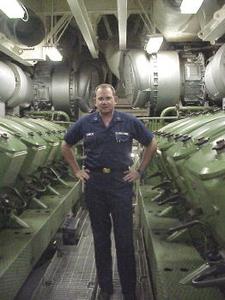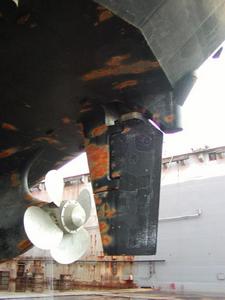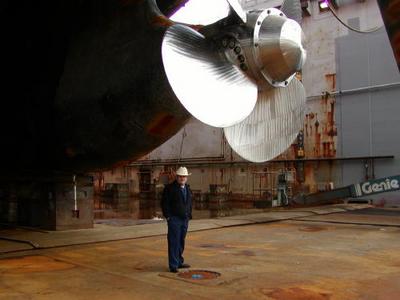
|
|
4 August, 2002
We started EB 2 early this morning under dark gray
skies, a strong wind, and rain. By the time we
finished, the sun was out and it felt warmer even
though the wind had not died down. Soon after
breakfast it clouded over again, and everyone on deck
had on all their cold weather gear by the time we
started our final station right after lunch. Shortly
after lunch someone spied a polar bear, but I missed
it! Weíve been among both small and large ice floes
and the bear had found a large one for itself. We
finally completed the East Barrow transect at dinner
time today. After dinner, Jim and I sectioned our
core (took the mud in layers and preserved it in cans
to go back to the University of Tennessee for
analysis). Later in the evening I had a chance to
talk with LT. Greg Stanclik, Engineer Officer on the
USCGC Healy.
Greg ducked easily under low areas of the ship as he
guided me on a tour of what makes this ship run. Even
though Greg is 6í6Ē tall, he looks small standing next
to some of the machinery! Greg has only been on board
the Healy for a month, but he sure knows his way
around and he clearly loves his job. It took us two
hours to complete our tour, and Iím going to try to
give you some of the highlights. We began in the
engine room where we found out that it takes four
engines to turn the shipís four generators. If all
four generators ran at one time (they donít), they
would generate enough power to light a small city!
There are 12 pistons/diesel engine, and each piston
produces 840 horsepower (thatís equal to the
horsepower of four big pick up trucks)! The
generators produce 6600 volt electricity which must be
transformed as low as 110 volts (what you would find
in the average household). This much power allows the
ship to run in open ocean at 12 knots while still
providing enough power for all the science equipment,
winches, and the general electricity for the ship.
Remember that the Healy is 420 feet long. Can you
guess how much fuel it uses? When the ship is
underway, it burns 5000 Ė 6000 gallons of fuel each
day, and it might use up to 20,000 gallons/day if it
is steadily steaming in heavy ice. The ship holds 1.2
million gallons of fuel which is stored in fuel tanks,
four to five decks high, along the sides of the ship.
There are very few places big enough to re-fuel this
ship, and it takes most of one full day to refuel. A
ship must always be balanced to ride smoothly and
evenly in the water. The Healy has a 30 foot draft
(the amount of the ship that is under the surface),
and it uses both water and fuel for ballast. As the
fuel is burned, itís replaced by sea water to keep the
ballast even. I found it interesting that the ship is
designed so the bow (front end) of the ship rides one
foot higher than the stern (back end). Thatís so it
can ride up and crush ice. The entire ship has a
displacement (the amount of water it pushes aside) of
16,000 long tons. Since one long ton equals 2240
pounds, thatís 35,840,000 pounds!
The Healy was designed to be a science research
vessel, but it is also specifically designed to work
in higher latitudes. It is definitely an icebreaker.
Underneath the ship is a solid steel wedge called an
ice knife approximately 6 feet high and 6-7 feet long.
Along each side of the ship is an ice belt, a 10
foot tall band of thicker steel running the length of
the ship. Everything that runs this ship is
computerized; the entire system is one of a kind for
the Coast Guard right now. We went to the Engineering
Control Center where the MPCMS, or Main Propulsion
Control Monitoring System makes everything happen.
The array of computers and the giant switchboard give
you some idea of the complexity of the entire
operation. There are 5400 monitoring points (ex. fire
and flood alarms, oil pressure, temperature, flow
meters from the sea water, etc.) that the computers
take in as data. An interesting note is that all
records are electronic and all are in Greenwich Mean
Time (thatís in England, at 0 degrees longitude).
Thatís because the company that made much of the
equipment (ex. main motors, MPCMS, etc) is based in
England and, if there is a problem, they can connect
directly through in order to trouble shoot.
How about just a few more interesting facts? Each day
when we are working to process our samples, we are
accompanied by the sound of the huge winches that
control the wire that lowers and raises the sampling
equipment. There are 6 drums of wire of varying
thickness. The wire goes to the 2 oceanographic
winches which are used for most of the oceanographic
instrumentation (for example, the van Veen grab and
the CTD rosette) and to the dual drum trawl/core winch
whish is used for large oceanographic equipment such
as the dredges and the coring system. You know that
the Healy is 420 feet long, but how tall is it? Itís
157 feet tall (thatís the height above the water line)
not including the radar array. It you add the draft
of approximately 30 feet, the ship is a total of 187
feet tall! Each time it goes out, it must carry
enough fuel for 65 days including a minimum of 12 days
at full power. In addition, it must carry 180 days
worth of provisions. Lastly, when it was delivered in
1999, it cost a mere $350,000,000! This is one
amazing ship.

LT. Greg Stanclik, Engineeer Officer on board the USCGC Healy, stands next to some of the pistons which power the engines. There are 12 pistons/diesel engine, and each piston produces 840 horsepower.

This is a picture of the switchboard in the Engineering Control Center (ECC). Check out all the computers behind us that are a part of the MPCMS or Main Propulsion Control Monitoring System.

This is a picture taken directly behind the Healy when it was in dry dock. This and the other dry dock pictures were taken by the previous Engineer Officer.

A side view of the rudder

The ice knife is a solid steel wedge beneath the ship. It's designed to cut any ice that gets that far.

It's much easier to understnad just how big the propellers really are when a person stands underneath one of them!
Contact the TEA in the field at
.
If you cannot connect through your browser, copy the
TEA's e-mail address in the "To:" line of
your favorite e-mail package.
|
